Introducing Janette Gross
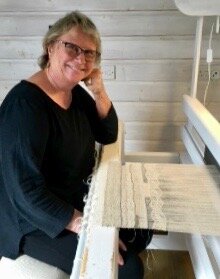 Janette Gross is a longtime SCTAG member who has held most of the guild’s leadership roles at one time or another. Her beautiful wedge weave tapestries, featuring amazing color gradations and artistically placed slits, have been shown in galleries and museums. Recently we caught up with her to ask about her life and art. Also, you can see some great pictures of her work in the article she wrote for the American Tapestry Alliance magazine, which is included at the bottom of this profile.
Janette Gross is a longtime SCTAG member who has held most of the guild’s leadership roles at one time or another. Her beautiful wedge weave tapestries, featuring amazing color gradations and artistically placed slits, have been shown in galleries and museums. Recently we caught up with her to ask about her life and art. Also, you can see some great pictures of her work in the article she wrote for the American Tapestry Alliance magazine, which is included at the bottom of this profile.
An interview with Janette:
How long have you been weaving? After stopping full time work as Director of Administration for an architectural firm in Berkeley, I started weaving in 2003 with a one day rigid heddle class at the Taos Wool Festival in New Mexico. I followed up with a once a week class led by Jan Langdon at the Richmond Art Center in Richmond CA. Substitute teacher, Peggy Osterkamp and a summer workshop in wedge weave with Deborah Corsini got me going on my current path.
How long have you been in SCTAG? Which offices have you held? I joined the guild in 2005 when I moved to Santa Cruz full-time. Before that, I belonged to the Golden Gate Weavers in the East Bay. I have been Treasurer, Vice President, President and Program co-chair.
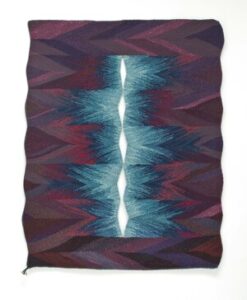
You concentrate on tapestry weaving on a loom, any advice for those wanting to try that? I was on a floor loom when I began weaving weft face pieces which were mostly rugs. Since my tapestry work is really rugs hung on a wall, I prefer to keep working on my floor looms for bigger pieces. I have a Glimakra and an Ahrens. It is easier on my back and arms weaving on a floor loom tilted up with bricks under the back legs (a Martha Stanley trick). The down side is that I can’t see my whole piece at one time the way I would with a vertical tapestry loom. Instead, I take photos as I go along and paste them together as reference of where I’ve been. Sometimes, I pull the piece out to review it, then carefully roll it back on the front beam with help from others to keep it straight and under tension. I also have a little Mirrix tapestry loom for studies and smaller pieces.
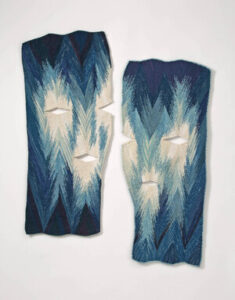
You focus on wedge weave. Any early mentors? Any primary resources you refer to? My first exposure to wedge weave was a 5 day workshop with Deborah Corsini who had been a student of Martha Stanley’s. I had seen pictures of Martha’s work in Jan’s class and I just fell in love with Martha’s wedge weaves. This is what prompted me to take Deborah’s summer workshop. When I moved to Santa Cruz and attended my first guild meeting, Martha was the first person to walk up to me and introduce herself. It was fate! Later I learned that she had previously given a rug workshop in her studio for guild members. I talked her into doing that again for the newer guild members. There was also a guild rug group that met periodically and I joined that. After Martha’s rug workshop, a few of us who could, continued to come and work on projects in her studio. We have now been weaving there for over 10 years. My resources for wedge weave are mostly practice, practice, practice. Martha was no longer weaving wedge weaves and did not direct mine or others work in the studio. If asked she might make an observation that would make us think and use each other as a resource but she didn’t supply “the answer.” My two favorite examples are 1) when I began my first bigger sized wedge weave and had woven about 18″ on a 22″ wide piece, I went across the room to look at it and I knew something was wrong but I couldn’t put my finger on it. I think Martha said something like, maybe you should think about proportion. I did and realized that I’d scaled up my design way bigger than the actual piece could handle! Out came 18″ of work and I started all over again. The completed piece became my first award winner! The second little bit of observation from Martha was when I began weaving more open slits in my pieces. I asked her to come look at what I’d woven because I wasn’t quite happy with it. All she said was – well, it’s not very elegant. Bingo. It wasn’t. The inside of the slits are really selvedges and they were sloppy. Rip, rip, rip. Now only elegant slits are allowed!
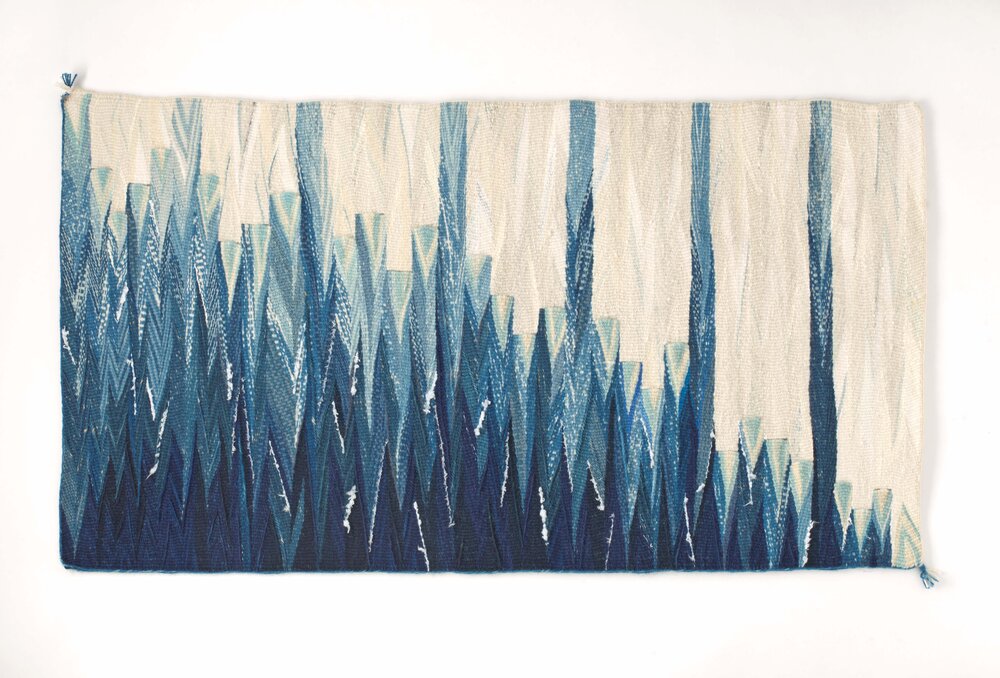
Where do you find inspiration for your designs? Inspiration comes from everywhere. A lot from my travels but mostly through color since I don’t weave pictorial pieces. I love color and I love dyeing my yarns. I also find inspiration in the technique itself. I really enjoy seeing what I can and cannot do with wedge weave. I have notebooks full of doodled wedge weaves. I also think weaving a piece for a themed exhibit is good. It makes me stretch my themes into areas I might not have tried otherwise.
Anything else you’d like to add? Below is a piece I wrote for the American Tapestry Alliance journal about inspiration. I really can’t over emphasize how wonderful it is to weave alongside others weavers. Between the studio group at Martha’s and our Yarnettes program, I have learned so much and that learning continues. And guild programs too of course!
Alchemy and Chocolate by Janette Gross
Alchemy: “…a power or process that changes or transforms something in a mysterious or impressive way.” Merriam Webster
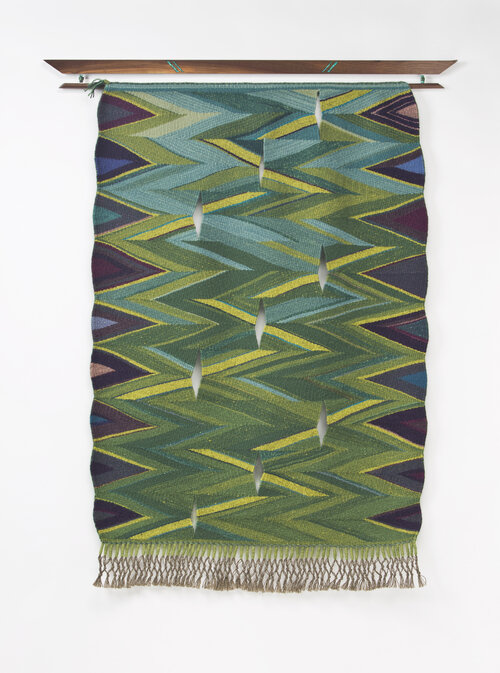
Wedge Weave with slits. Wool warp and weft over-dyed with indigo. Inspired by the rolling green hills of the tea plantations and the bright saris of the tea workers in India.
My weaving journey has been a delightful process of alchemy. The transformation in me and my work has been supported and encouraged by those around me. I began weaving in my late 50s, after leaving full time work. A friend treated me to a weaving workshop in Taos where I fell in love. Fiber, textiles and Taos, how could I not? I followed up with weekly lessons back at home.in a class that included new and experienced weavers. It was a wonderful way to begin. I had encouragement and guidance from the experienced weavers and a much needed emotional support group with the beginners. After a few years of classes and workshops, I was in a workshop with a woman who lamented that she never focused on any one technique. Instead, she just kept taking workshops. By that time, I knew I was really drawn to wedge weave. With her comment in my mind, I decided to focus on the technique and to do it to the best of my ability. I still take occasional workshops, including a return trip to Taos for a week of natural dyeing. I will also sign up if the teacher is someone I am interested in for their unique artistic outlook, or to learn something new in a shared experience with friends.
Without a formal education in textiles, I have used travel to expand my knowledge about this wonderful and diverse field. I am a tactile person. I prefer seeing artisans working at their looms or with their dye pots to reading about them. I seek out experiences with a hands-on component. I bring back memories (and many hundreds of photographs) of interesting techniques, and of color. Each place has distinct colors for me. I love the many greens from tea plants dotted with the colorful saris worn by tea workers in India. The beautiful indigos of the hill tribes in Vietnam and in the shibori fabrics of Japan are represented in many of my pieces. The bright yellow silks in Cambodia, the wonderful madder reds still vibrant in ancient textiles in France, and the brightly colored rugs of Mexico and Morocco all become a part of my memory palette.
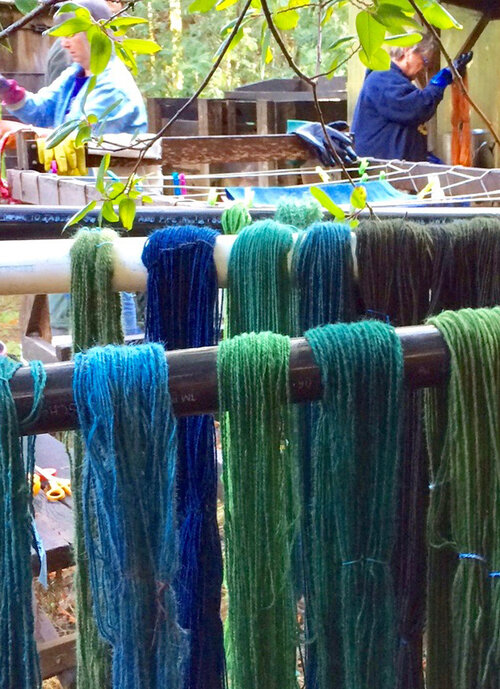
I learn a great deal from artisans on my tours and from other tour members as well. Surface and clothing designers, quilters, basket makers, complex weavers, natural dyers, and educators all help me to see things in different ways. Conferences and textile groups to which I belong also add to my expanding view. These different viewpoints burrow into my mind and often surface when I am planning or working on a project. I agree with those who call this “part of the tool box.”
I prepare yarns at home and I sometimes weave there. Mostly I weave and dye in the studio of our friend and mentor, Martha Stanley. Our group of six was formed over ten years ago when Martha hosted and taught a workshop for guild members. When the workshop was complete, she asked some of us to continue weaving in her studio. We have our own looms set up in her converted barn. At the outdoor dye area, several natural dye pots are usually going and always an indigo pot. Many experiments take place at the dye pots, from ikat resist to shibori to overdyeing one color with another. Our drying lines fill with beautiful dyed yarns that inspire and encourage my work with color.
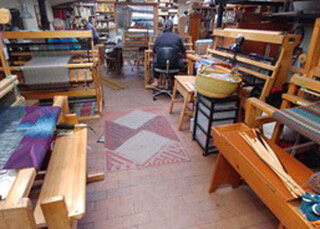
We thought Martha would continue teaching us but she had something else in mind. She wanted us to learn by working seriously at our looms (not so much talking!) and then working out problems together when we struggled with doing it alone. She adds suggestions from time to time, like listen to the cloth, and to step back and look at your work from across the room, or from up on your loom bench or even, climb up on the roof and look down through the skylight! Mostly she acts like a therapist, tossing questions back at you so you can answer them yourself.
We continue to marvel at what an amazing and unique group we have. We do our own work, which is often very different. Sometimes Martha will bring out pieces from her extensive textile collection for us to analyze and learn from. Our guild library is housed in the studio, making written resources readily available. As we each travel and attend conferences, we bring our experiences back to the studio. Most of us like to experiment in the kitchen as well as at the loom. Pot-lucks happen, especially when visitors are scheduled. In our time together, we have experienced illnesses, family deaths, personal and world tragedies. Although we support one another through these situations, we try to make Martha’s studio a respite from them. There is no internet or cell phone service, just a landline with sketchy reception in the studio. This environment enables us to concentrate on our work and figure things out without the normal distractions of daily life. Our ability to express a thought or a problem to willing ears is invaluable. Sometimes just the expression of the problem out loud can lead to one’s own solution. Other times, it is really helpful to hear from others. Have you thought about…? What if you did this…? Why did you do that……? Have you looked at it from this angle…..? How does it make you feel…? Would some chocolate help?

Janette Gross – Rydell fellowship award In her own words:
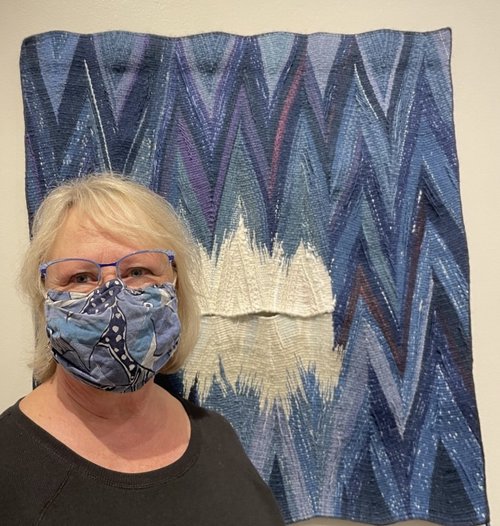 Last summer the San Jose Museum of Quilts and Textiles (SMQT) nominated me for the Rydell fellowship. They become aware of my work though several Tapestry Weaver’s West shows, and the American Tapestry Alliance’s ATB13 show, and as a member artist. I completed the extensive application and waited for many months. In December I found out that I was awarded one of four fellowships given for 2022 and 2023. Following is the description of this fund and a little about the judges. It’s important to note that this award is for all visual arts not just for textile arts. I understand that I am the first tapestry artist to receive this fellowship. Yay for tapestry!
Last summer the San Jose Museum of Quilts and Textiles (SMQT) nominated me for the Rydell fellowship. They become aware of my work though several Tapestry Weaver’s West shows, and the American Tapestry Alliance’s ATB13 show, and as a member artist. I completed the extensive application and waited for many months. In December I found out that I was awarded one of four fellowships given for 2022 and 2023. Following is the description of this fund and a little about the judges. It’s important to note that this award is for all visual arts not just for textile arts. I understand that I am the first tapestry artist to receive this fellowship. Yay for tapestry!
Roy and Frances Rydell established the Roy and Frances Rydell Visual Arts Fund in 1985 to promote Santa Cruz County artists and arts organizations. Four artists are chosen every 4 years.
For this round of fellowships, 51 artists completed the application from a candidate pool nominated by 26 local and regional visual arts organizations and former Rydell Fellows. Nominees were limited to working artists, 25 years or older, who reside in Santa Cruz County and are not enrolled in a degree-granting program.
Nominating organizations were asked to consider the broad disciplines the Rydells thought of as part of the visual arts: painting, drawing, printmaking, ceramics, sculpture, installation, mixed media, stage set design, photography, costume design, textiles, glass, film and video. In October, a panel of three nationally recognized arts professionals met at the Foundation to judge the artists’ works and select the fellowship recipients. The panel members were Maori Holmes, artistic director and CEO of BlackStar in Philadelphia; Garth Johnson, Paul Phillips & Sharon Sullivan, curator of ceramics, Everson Museum in Syracuse; and Astria Suparak, independent curator, former director and curator of the contemporary art galleries at Carnegie Mellon University in Pittsburgh and Syracuse University.
Gifts allow artists uninterrupted creative time to focus solely on their work and its impact on the local community and the larger world. The fellowships help individual visual artists pursue their creative work and are made solely on the merits of their artistry and not tied to the completion of any specific projects. Each fellow receives $20,000.
I will be taking my fellowship in 2023. In January of 2024, all four artists will show their work at the Museum of Art and History in Santa Cruz and a catalog will be produced. I am currently working on a plan to weave a series of new tapestries with churro wool from a Navajo co-op. The purchase of the wool will support this organization and honor the weavers whose wedge weave designs have so inspired me. I have other ideas percolating and hope to get working on them as soon as I stop floating off the ground!